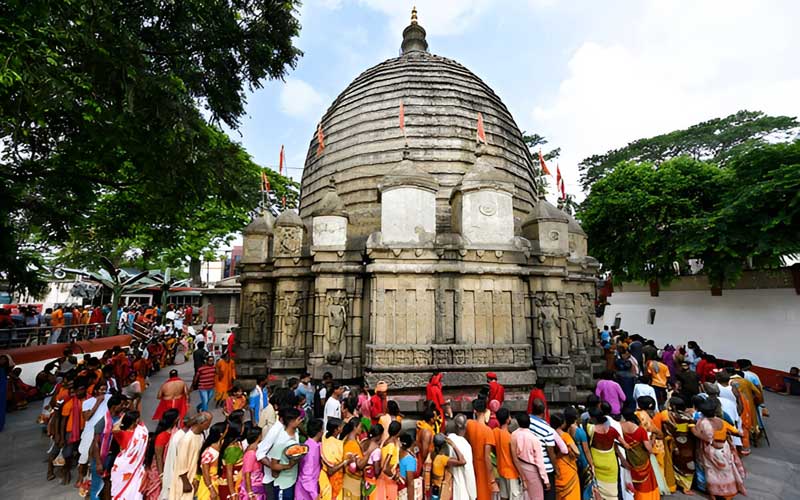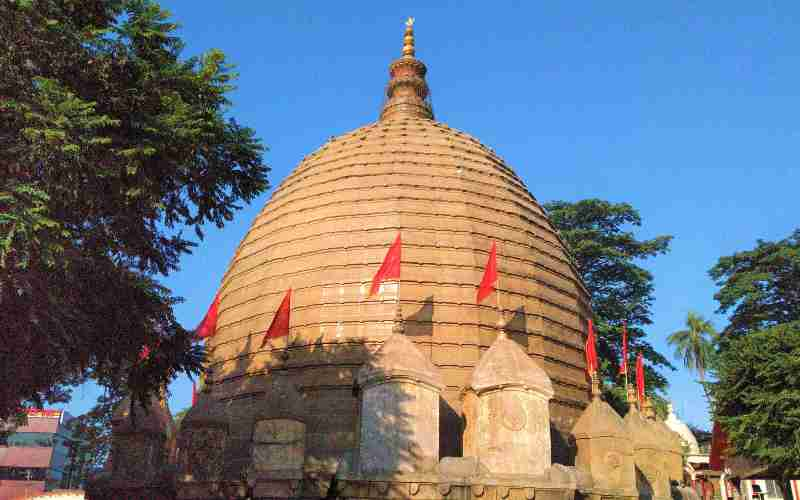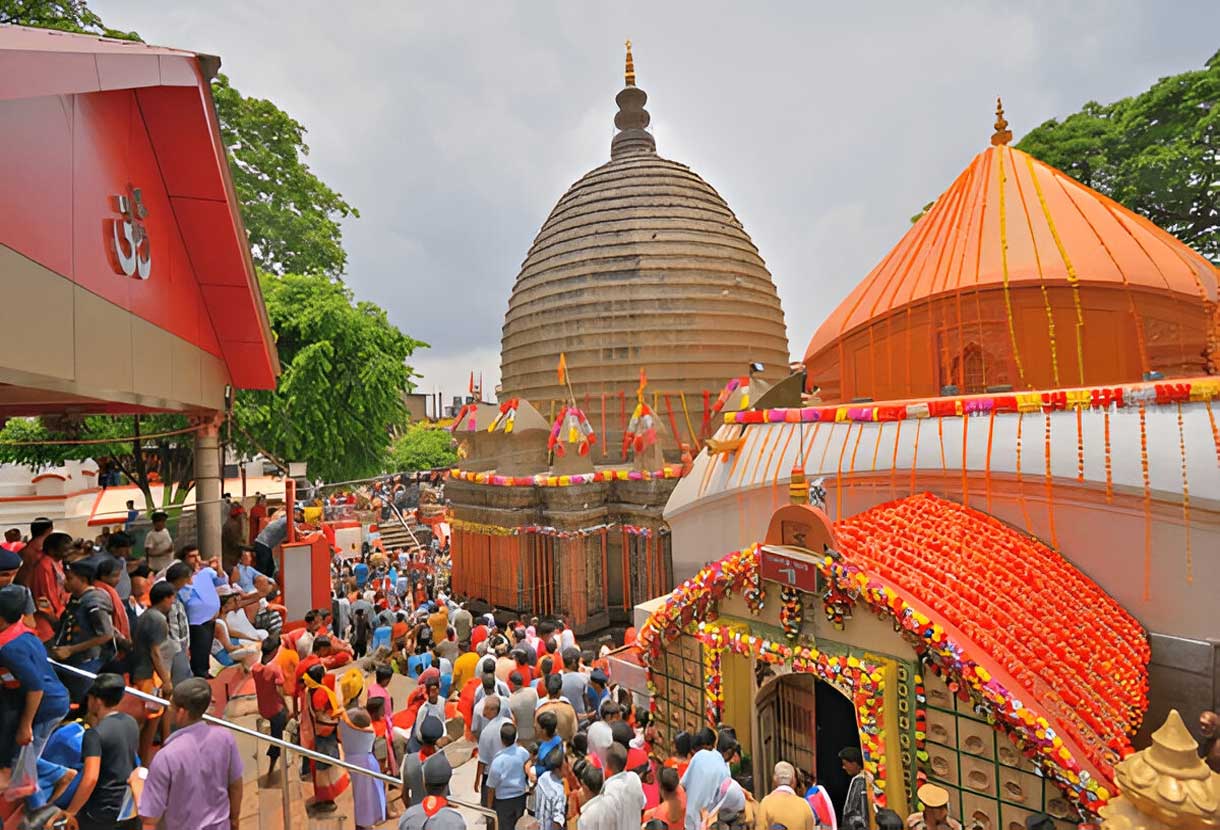The Ambubachi Mela is a vibrant festival celebrated annually at the Kamakhya Temple in Guwahati, Assam. This event marks the divine menstruation cycle of Goddess Kamakhya, symbolizing fertility and womanhood.
Held on the sacred Nilachal Hill, the festival draws thousands of pilgrims, sadhus, and tourists from around the world. The Kamakhya Temple, one of the 51 Shakti Peethas, becomes a hub of spiritual activity during this time.
The temple doors remain closed for three days, reflecting the goddess’s period of rest. On the fourth day, they reopen, welcoming devotees to offer prayers and seek blessings.
This festival is a profound celebration of the divine feminine and natural cycles.
Origins and Mythology of Ambubachi Mela
The origins of the Ambubachi Mela are steeped in deep mythology. According to Hindu beliefs, the festival celebrates the fertility of Goddess Kamakhya, who embodies nature’s cycles.
The Kamakhya Temple, where the festival unfolds, is legendary. It is said to be the place where the yoni (womb) of Goddess Sati fell, making it a revered site.
This mythological background plays a crucial role in understanding the spiritual depth of the festival. It highlights the celebration of natural phenomena such as the monsoon and harvest.
Key aspects of the mythology include:
- The menstruation of Goddess Kamakhya.
- Recognition of divine feminine powers.
- Connection to the Shakti Peethas.
Ambubachi Mela offers spiritual renewal through its rich, mythical foundations.

The Kamakhya Temple: A Sacred Shakti Peetha
The Kamakhya Temple is more than a religious site; it is a significant Shakti Peetha. These are revered in Hindu tradition, marking the spots where parts of Goddess Sati’s body fell.
Perched atop Nilachal Hill, this temple offers stunning vistas of Guwahati, Assam. Its majestic architecture and serene ambiance draw countless pilgrims and tourists every year. The temple’s distinct style is evident in its ornate carvings and vibrant imagery.
Key features of the Kamakhya Temple include:
- Dedicated to Goddess Kamakhya.
- Renowned for its tantric significance.
- Home to multiple smaller shrines.
An aura of spirituality envelops the site, heightening its importance. This sacred ground is pivotal in the celebration of the divine feminine.
Rituals and Traditions During the Annual Ambubachi Mela
The Ambubachi Mela is steeped in rich rituals and vibrant traditions. It observes the natural cycles related to Goddess Kamakhya. These rituals mark the goddess’s yearly menstruation, celebrating fertility.
Throughout the festival, devotees participate in many spiritual practices. These include chanting, meditation, and offerings. Each activity reflects reverence for the divine feminine, honoring its power.
Essential offerings to the goddess during the Mela include:
- Red cloth symbolizing menstruation.
- Fruits and flowers representing abundance.
- Traditional sweets as tokens of devotion.
Devotees believe these rituals cleanse the soul and invite blessings. The air resonates with spiritual chants and divine melodies, creating an atmosphere of devotion and peace.
The Mela also highlights Assam’s cultural diversity. It is a time for sacred unity, where individuals from different backgrounds converge. Participants exchange ideas, creating a cultural mosaic.
The Closing and Reopening of the Temple Doors
The Ambubachi Mela includes significant rituals involving the temple doors of Kamakhya. These doors close for three days, symbolizing the goddess’s period of rest. This marks the divine menstruation of Goddess Kamakhya.
During this closure, no worship occurs inside the temple. Devotees await eagerly outside, respecting this natural cycle. It is a period of reflection and anticipation for many.
On the fourth day, the temple doors open with great ceremony. A wave of spiritual energy fills the air. Devotees flood in, offering prayers and seeking blessings, celebrating the renewed access to divine grace.

Cultural and Social Impact on Guwahati, Assam
The Ambubachi Mela leaves a profound cultural mark on Guwahati, Assam. It draws in spiritual seekers and tourists alike. This influx boosts local businesses and revives the regional economy.
For many locals, the festival is more than a spiritual event. It is a social spectacle filled with vibrant customs. Artisans and vendors thrive during this bustling occasion.
Numerous activities highlight the richness of Assamese culture. These include:
- Craft exhibitions displaying local artistry
- Traditional Assamese music and dance performances
- Culinary offerings of regional delicacies
The festival encourages cultural exchange and dialogue. It unites people from varied backgrounds. This interaction fosters a sense of communal harmony and understanding.
The Experience: Pilgrims, Sadhus, and Visitors
The Ambubachi Mela is a vibrant tapestry of diverse experiences. Pilgrims, sadhus, and curious visitors converge in Guwahati, creating a dynamic spiritual atmosphere. Each comes seeking unique spiritual blessings and cultural insights.
Sadhus, with their colorful robes and ash -smeared bodies, are key figures during the festival. They offer wisdom and blessings to all seekers. Their presence adds a mystical aura, captivating many visitors.
The festival becomes a melting pot of cultures. This diverse mix creates an enriching experience for everyone. Engaging with different people and practices brings new perspectives to life. Key experiences include
- Witnessing traditional rituals and ceremonies
- Engaging in spiritual discourse and meditation sessions
- Exploring local markets and sampling regional cuisine
- Preserving Heritage and Embracing the Divine Feminine
Ambubachi Mela serves as a custodian of rich cultural heritage. The festival’s rituals have been passed down through generations. It remains a cornerstone of Assam’s spiritual identity.
Celebrating the divine feminine, the festival underscores the power of womanhood. Goddess Kamakhya’s worship embodies fertility and creation’s cycle. This acknowledgment of feminine energy fosters respect and balance in society.
Conclusion: The Enduring Legacy of Ambubachi Mela
Ambubachi Mela’s legacy is woven into the cultural and spiritual tapestry of Assam. This ancient festival has attracted countless devotees, fostering a sense of unity.
Its influence extends beyond religious boundaries, bringing people together. As a celebration of nature and the divine feminine, Ambubachi Mela remains ever-relevant. It continues to inspire those who seek spiritual solace and connection. By honoring age-old traditions, the festival ensures the preservation of significant cultural values for future generations.






